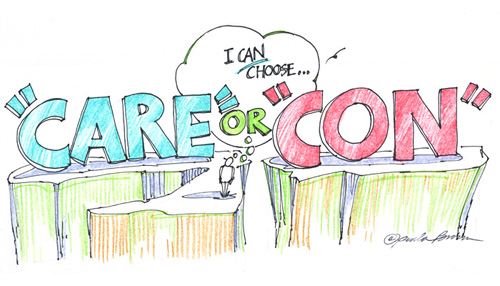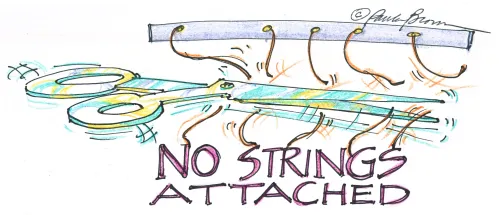May, 2016
HOW TO BRIDGE COMMUNICATION “CHASMS” WITH CAREFRONTATION VS CONFRONTATION.
 Communication springs from emotional messaging…you have a choice of positive Carefrontation: trust and open (win / win), or negative Confrontation: force and accusatory actions (loose / loose).
Communication springs from emotional messaging…you have a choice of positive Carefrontation: trust and open (win / win), or negative Confrontation: force and accusatory actions (loose / loose).
I am writing this blog to help share positive points learned from a recent experience of mine. Just found closure in a copyright infringement situation where I found myself receiving a strong confrontation communication strategy that evolved into passive aggressive stalled out mode. Due to this non caring confrontational “style”, separation of what each individual desired increased, stuck got more stuck, and false promises resulted in failure.
There are times when you just “have a failure to communicate” (Take note from the movie “Cool Hand Luke”!). The wide chasm between contrasting points of view are not to be bridged, both parties suffer. Each side digs in, stuck in the muck of righteousness, frustration, anger as well as fear. Disagreements happen all the time…that is how change happens! Is there a way to guide disagreement from confrontation into a caring and value oriented process?
Confrontation communications: A story of reactive and conditional resolution.
The tale told with confrontation begins with a “con”. The story begins with a negative assumption (you are wrong and I am right). The frontline is set for attack, not talk. Lines are drawn, strings attached, sides are formed, and a battle begins. Storylines hold little flexibility, requirements to “submit” to strong-arm strategies are present. A feeling of having to win, of setting restricting conditions to settle, create the rules of confrontation. Winners and losers are defined, in reality there are NO winners.
Does confrontation in business create benefit or give value? Most of the time it comes as a shock to a system, defines or brings awareness to some sort of issue that needs healing, errors, power struggle, etc. Value added: Identifies agendas, revealing possible hidden needs that show up in “surface level” disagreements, and singles out those folks who find it enjoyable to feed disruption at hand to call attention to their own personal disharmony.
When a “failure to communicate”, comes into crisis mode, is there a way to avoid reacting with force, and confrontation?
YES, you do have the power to choose!
Carefrontation communications: A story of listening, purpose, and building trust.
Think of the Dali Lama as global mediator, with his words:
“Happiness depends on inner peace, which depends on warm-heartedness. There’s no room for anger, jealousy or insecurity. A calm mind and self-confidence are the basis for peaceful relations with others….”
Happiness: creating room for open discussion without anger, accusations, listening to what others or situations really need is what could happen when authentic leadership, strength, power (not force), and calm, are brought to build the reality and emotion of trust, and loyalties.
How can you be powerful when you are angry?
When you are angry, your body physically tenses up, your breath shortens, and you go into protection or attack mode. Power is lost, and force is the strategy at hand. What to do?
BEGIN WITH YOURSELF: CONSCIOUSLY CHANGE YOUR ANGER TO CALM (it’s all about emotional “safety”):
1.Take DEEP BREATHES, at least three…relaxing your body. Try it out, you can not be angry when your body is not tense!
2. Step back from judgment, PAUSE. Write down the exact issue to be discussed without emotional context, no “conditions”.
3. SET AGREED UPON BASIC RULES. Like time limit per response, no interruptions, no accusatory language…build your safe communications space.
4. ACKNOWLEGEMENT: Comes down to it…folks want to be acknowledged, emotionally and mindfully…so do you…you need not agree to all that is on the table…you could do well to acknowledge what is there, what other’s bring as well as what you bring. FIND PURPOSE: Listen without interruption, let them talk (if they get abusive, let them know you will resume the conversation later or merely ask them “why” they are angry if possible)…then repeat their needs as stated and ask if you have their desire accurate, in a calm and confident manner.
5. STATE YOUR NEEDS with calm, firm conviction.
6. Point out any items which are mutuaL. Then take each opposing point and rank each to their importance for either of you…now you have an “importance scale” to discuss as well as an agreement list. Offer to send a written summary so both of you can review.
This is just a beginning in showing “care” (power, not force) for the topics and “being” of you and others. Building emotional trust, safety inside open discussions, a true container for change.
The values of a carefrontation communication:
Carefrontation can be a big “pro” on the value added scale:
1. Leadership is established from talking non-judgment, just the facts, simply stated and examined.
2. Both “sides” are transformed / elevated in a positive manner by true listening and exchanging of needs. Physically, a benefit of stress reduction for the emotional and physical body of all.
3. You create RELATIONSHIPS rather than dictatorships.
4. Discovery of REAL needs, commonalities that create trust and positive emotional connections.
5. You show you care by listening, a value that builds trust, loyalties, and agreement (not just agreement to what you want!).

No strings attached carefrontation.
With a true carefrontation, there are no “conditions”, no strings attached. A gift of resolution between parties.
If for some reason you cannot establish a two-way caring discussion (and that does not mean hugging folks left and right) with another, you may have to bring in a professional mediator who can. In my case, I decided to use what the Hawaiian’s call “mana” (one’s power from within that gives you the guidance in changing your own actions) to respond, coming from a position of power, caring, and to remain calm in my communication, which made my process of ending partnership in a non judgmental manner.
You may think that my story ended in failure. For me, it was not. By caring how I communicated, bridges WERE built, the choice was made to not cross the bridge! That’s my tale of choosing carefrontation that was triggered by confrontation.
Building bridges with listening, calm, purpose, and power is the story I wish to share!
Thank you for taking time to share, build bridges!
I’m Paula Brown, Visual Scribe / Purpose Discovery Guide / Author. I am a visual storyteller and “purpose guide” showing you many possibilities to IGNITE YOUR STORY, YOUR ENERGY, YOUR WELL-BEING for both business and home. My site is: www.chilightful.com Connect on: LinkedIn, Twitter. and you can “like” my facebook page at: www.facebook.com/ChiLightful
